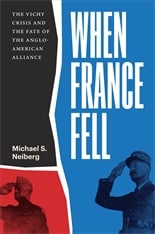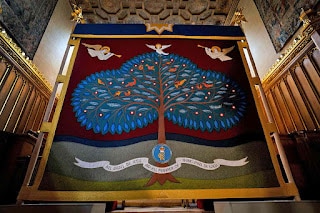What is it about World War II that it still resonates and fascinates, now still after almost 80 years? My generation, of course, grew up in the aftermath and under the long shadow of that war. We were surrounded as kids by veterans of the war and by a seemingly endless supply of war-related movies. Yet, even as the « Greatest Generation » has faded from the scene and as we Boomers begin our own fade away, interest in World War II continues. One factor, I suppose, is that it was not only the largest great power military conflict of all time but also the last of its kind. One of the evident benefits of nuclear weapons is that they have successfully deterred another World War II style conflict between the great powers. There is also the idea that World War II was « the good war, » perhaps our last unambiguously good war, the last war the U.S. actually won.
Yet, even when it comes to World War II, popular fascination focuses on certain familiar times and places while others, where the war did not seem to go as well, tend to get less attention. One of those other times and places is the French collaborationist Vichy regime and the United Stats’ perplexing relationship with it. Stepping into this gap, distinguished 20th-century military and war historian Michael Neiberg has written a history of the relations between Vichy (led by Marshall Petain and Pierre Laval) and the western Allies, When France Fell: The Vichy Crisis and the Fate of the Anglo-American Alliance (Harvard U. Pr., 2021), which I have just finally gotten around to reading.
The fall of France wa unexpected. France did, after all, have the largest army in Europe at the time. The British, obviously, were traumatized by France’s quick defeat and ignominious surrender. So too was the United States, whose isolationism (or, more accurately, non-interventionism) had largely been premised on the benefits of relying on the British navy and the French army. All of a sudden, the latter was gone, and the U.S. seemed much more exposed (especially from the proximity of French territories in the Americas).
From the start, the U.S. tried to maintain good relations with supposedly neutral Vichy. The British had inevitably alienated Vichy by its apparently necessary attack on the French fleet. The British had also recognized Charles de Gaulle, whom Vichy, of course, considered a traitor, as leader of the « Free French. » The U.S. was not encumbered by the baggage of the conflict between Britain and Vichy about the French fleet. Moreover, the U.S. for as long as possible stubbornly – obsessively, one might suggest – refused to recognize de Gaulle. Instead, it made every effort to remain on good terms with Vichy, in spite of Vichy’s increasing unpopularity in the U.S. and the increasing popularity of and respect for de Gaulle among the American public.
In addition to this basic error, the American response to the French situation was plagued by a failure to appreciate the importance of their empire to the French. Continued French control of North Africa and the rest of the French Empire was important to all the otherwise competing factions among the French.
Neiberg’s account gets even more detailed and interesting when it is time in the narrative for Operation Torch, the American and British invasion of French North Africa in November 1942. Operation Torch forced the ostensibly neutral Vichy French officers in North Africa to choose sides. The most significant one to do so was, of course, the infamous Admiral Darlan, whose decision to cease fire and make a deal with the Americans certainly saved many lives. It was, however, a collaboration with unsavory Vichy types that American (and British) public opinion was increasingly horrified by. It was a marriage of extreme convenience, which had the advantage for the Allies of avoiding having to settle the rivalry between the two competing non-Vichy French Generals – de Gaulle (favored by the British) and Giraud (favored by the Americans). Again the Americans backed the wrong horse.
By this time, of course, the Americans – at least the American military – understood that there were no perfect choices. Neiberg quotes Eisenhower as saying of the French, « all of these Frogs have a single thought – ‘ME’. »
Meanwhile, fate intervened with the Christmas-Eve assassination of Admiral Darlan. Neiberg recounts the unrealistic expectations of the royalists that killing Darlan would clear the way for the Comte de Paris to come to Algiers and establish a unity government as King Henri VI. Needless to say, that didn’t quite work out either!
In deference to the absent Soviets (preoccupied with Stalingrad), the January 1943 Casablanca Conference was supposed to focus on military matters only, but France post-Darlan had to be dealt with. According to Neiberg, « policy on France came to symbolize American missteps as much as it reflected an inability to force the British to hew to American desires. It may also have reminded [U.S. Secretary of State Cordell] Hull of American inexperience on the world stage. » The British saw the Americans’ continued backing of Giraud as a continuation of their support for Darlan and, before him, Pétain, and the British continued to back de Gaulle.
Eventually, of course, de Gaulle outwitted Girard and the Americans, and by the liberation of Paris in August 1944, he was clearly the leader of a post-Petain France. Meanwhile, Petain. Laval, and what was left of Vichy were taken to Germany. « The morbid and bizarre scene of the French government that the United States had once recognized being a virtual prisoner of the Nazis in a castle run by the Gestapo revealed what a broken reed America’s Vichy policy had been all along. Although Cordell Hull and his historian William Langer continued to defend the policy as the best of a bad set of choices, the events of 1944 revealed the leadership of Vichy France as the German prisoners they had been all along. »




